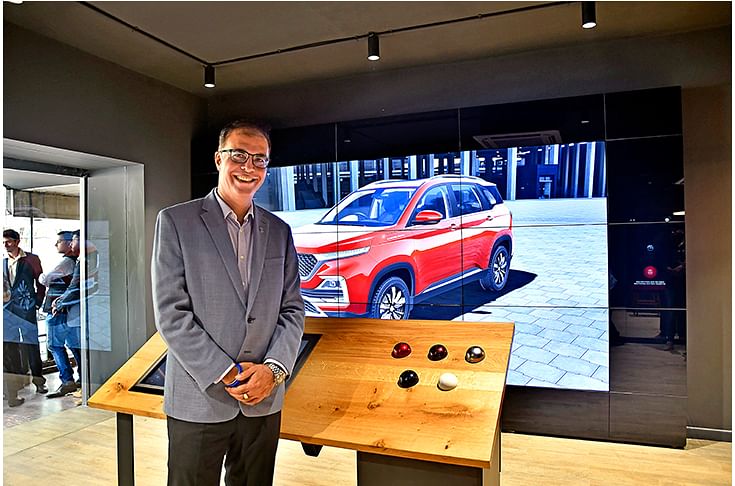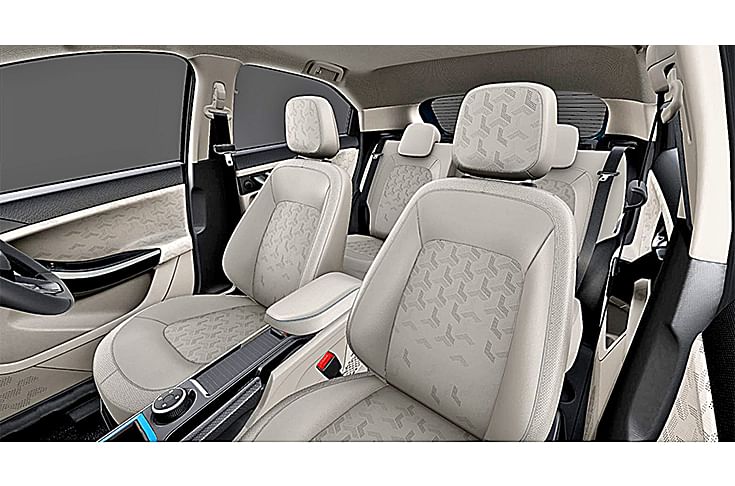Exclusive: Eccentric Engine deploys gaming tech to bring vehicles alive digitally
Mumbai-based Eccentric Engine, an image visualisation firm, is enabling OEMs to slash showroom and inventory costs and give customers an immersive and interactive digital vehicle experience without the need for an app.
In the time of lockdown, organisations and individuals alike are not just only struggling to keep themselves relevant, but also future-ready. The art of marketing is not only about selling a product or a service, but the ability to make a customer feel empowered and take the smart decision.
This is exactly what can be described as the reason why many automotive companies are investing in digitalisation, to better serve their customers, no matter where or when, by aiming to bring an immersive experience at their fingertips.
Mumbai-based Eccentric Engine, the creator of One 3-D, an automotive visualisation platform, is doing just that. The company was founded in 2012 by Varun Shah and Gaurav Rane, with an aim to utilise gaming technology to enable brands to engage with their audiences. In the first four years, they partnered with brands across industries: FMCG, tourism, banking and financial services and insurance and automotive. In 2016, the company decided to focus its services on the automotive industry. Eccentric Engine has a production unit in Pune and a research facility in Belgium.
Speaking to Autocar Professional, Varun Shah, CEO, Eccentric Engine, says: “In 2016, during our conversation with one of our automotive clients, we realised that every 360-degree view of a car in the world has a series of images stitched together and just not interactive. While immersive experiences were just starting to be available on VR/AR (virtual reality and augmented reality), these technologies were just not easily accessible to consumers. In fact, they are still not. We thought, ‘What if we give an immersive and interactive experience of a vehicle on the browser, without the need to download any app or using any device and democratise immersive vehicle exploration? This marked the beginning of One 3-D, our online-first vehicle visualisation platform.”

Rajeev Chaba, president and MD, MG Motor India, at the launch of the Digital Studio carless showroom in Bangalore last year. The carmaker has partnered Eccentric Engine for its ‘One 3-D’ automotive visualisation platform.
According to Shah, the company’s One 3-D platform enables OEMs to take their business omni-channel by providing rich, immersive visualisation across touchpoints. The platform allows a user to explore a vehicle digitally on their phone, tablet or computer, using a web browser, which means automakers can provide an accurate digital version of their vehicle to the customer, anywhere, anytime.
Eccentric Engine made news last year when MG Motor India launched its first digital car-less showroom in Bangalore on October 31, 2019. MG said its Digital Studio is a sharp departure from the traditional automotive showroom, showcasing the future of automobile retail. MG had partnered with Eccentric Engine for its One 3-D platform. The OEM said that with increased costs of operating a conventional car showroom including aspects like space, rentals and infrastructure; the new business model helps unlock operational efficiencies and offers more convenience as customer preferences move towards digital. The digital studio offers interactive product demonstration of the Hector SUV, using digital tools such as ‘Immersive Voice’ and AI-based human recognition. Apart from the interactive visualiser, the Digital Studio offers Augmented Reality (AR) and other digital engagement tools for customers.
Covid drives digitalisation
For decades now, car sales globally have been built upon personalised approach through dealerships, and touchpoints. Going fully digital may have not been then the right tool and was seen as more of having a marketing presence. But with the Covid-19 pandemic changing the dynamics of the acceptable societal behaviour and new norms, digitalisation is what exactly what the doctor ordered for the industry.
Explaining Eccentric Engine’s work, Shah says, “The irony is that OEMs have always had the ‘Raw Materials’ for digital visualisation, in form of their CAD (Computer Aided Design) files. CAD is an image file format used by AutoCAD, which is created by AutoDesk and creates 2-D and 3-D designs. CAD files hold information for these images, as well as drafting information. One 3-D helps them churn out the maximum content from these CAD files by taking these files as input and converting them into usable outputs. These outputs include immersive online visualisation, visualisation for dealerships and sales personnel and even the traditional images used for advertising and promotions. While developing the initial usable outputs from CAD takes around 60 days, visualisation is an ‘Always On’ process. One 3-D ensures constant optimisation and supply of assets, 24x7.”
For many, the images one sees on brochures and billboards are just simple clicks by photographers and edited by designers that may take a day or two. But not many may be aware that “A typical OEM spends more than the cost of a luxury car just to create images for a brochure during a launch. This cost multiplies with every facelift or refresh,” says Shah.
While Shah remains tightlipped about the exact cost that goes behind bringing these images to life by Eccentric Engine, he says the cost for an OEM depends on a lot of factors — depending on the vehicle maker's product range, touchpoints and content streams it plans to cover. Accordingly, the company suggests the best Subscription Plan so that they obtain 'Maximum' outputs, in 'Minimal' investment. The Metric to track here is ‘Cost per Unit Content’. One 3D helps obtain substantial savings in the long term. One 3D Subscription includes warranty for additions and modifications in a model. Whenever there is any change or addition in the vehicle range, One 3D adapts the visualisation for the same. So, there is complete visibility to decision makers, on their investments and the value they get from it,” says Shah.
After over 45 days of lockdown in many parts of the country, many dealerships are now restarting operations but with the new norm of social distancing, drawing customers into showrooms would not be an easy job. Hence, enabling potential customers to view the car in totality not just the outside, but the interiors, along with allowing them to see all the customisation possibilities at their convenience will become a key sales enabler, a solution that Eccentric Engine provides.
Maximising gains with a digital approach
So exactly what are the benefits derived through this digital journey? Shah says, “It is time we start removing the word ‘digital’. An experience has to be digital. Benefits of the same for consumers is like comparing e-commerce with conventional retail. They have been ready for a while now (digital channels). The strategic benefits to an OEM include reduction in sales cycle, increase in per vehicle profitability, optimising the dealer inventory and customer loyalty. There are a lot of data points one can derive, speaking on the impact of One 3-D visualisation platform includes — Reduction in the Exploration-to-Retail cycle by up to 30 percent; up to 30 percent increase in per vehicle accessories sold and increase in website vehicle exploration duration by 3x.“

Tata Motors is among the many OEMs that Eccentric Engine is working with. The One 3-D platform was used to create the Tata Nexon's interior visuals.
Eccentric Engine may be one of the newest players on the block, but it is competing with the big boys in the data visualisation industry. While Shah does not reveal all his clients, it is understood in addition to MG Motor India and Tata Motors, the company is working with several leading OEMs not just in India, but also in the European markets.
Explaining the USP of the company, Shah says: “Our USP is ‘Online First’, while most automotive visualisation products are made from the point of view of creating content for offline/mainstream advertising and then trying to adapt to online 3D visualisation. Our approach with One 3-D was to go ‘Online First’ and then derive other traditional content from that. Which goes back to our origins — ‘Give an immersive 3D experience of the vehicle to anyone having a smartphone. We manage to provide a photorealistic 3D-tour of a car despite reducing the size of the object (file) to under 14 MB. This includes the vehicle exterior and interior. Most of the players have not been able to provide an interior 3D exploration, even in a file size of 50 MB. We have the world’s fastest renderer designed for automotive, that can give you a full-HD image within 2 minutes, which is quite a shift from the traditional rendering. One 3-D Visualisation has adapted itself, with a lot of learnings, to the needs and usage of dealer sales executives. Vision One 3-D, our configurator solution, has more users than any other automotive configurator in the world with over 10,000 monthly active devices.”
At present, the company offers three key products to the automotive industry:
- One 3-D: Its flagship visualisation platform that helps generating all visual content at scale.
- Vision One 3-D: Its configurator solution that helps close the gap between visualisation and price quotation.
- Content Automation Platform: Helps in personalising content basis intent and demographic preferences, which means an OEM can have a mass-scale customised engagement designed using various data points.
“We have one more product in the works will potentially reduce the CGI/image rendering costs by almost 4x. This would be a huge disruption as it accounts for significant costs and is populated by smaller unorganised players who lack scale efficiencies, which technologies can bring,” adds Shah.
Future trends and growth opportunities
Can AI and digital tools take over the role of dealerships? The answer is no. While it is expected digitalisation will see significant adoption and acceptance by consumers, these tools will aid customers for their purchase decision. “The pole star for digital transformation is simulating the dealership experience at homes, so that you do need minimal personnel/physical intervention in customers purchase decision. We are in the process of marrying visualisation with actual dealership scenarios/ conversations by covering a lot of scenarios that happen at the dealership floor. For example, what are you likely to ask your sales executive when you sit in the car for the first time? At what stage are you likely to enquire about accessories or other variants? These are all conditions we are integrating with One 3-D. Of course, at some stage you would expect human assistance, but can we allow a customer to make bulk of his decision making till then,so that the human can attend to more people and sell more vehicles,” asserts Shah.
The lockdown to contain Covid-19 across India and many other countries hardly seems as a deterrant for an optimistic Shah. He says, “It has been a very very busy period to say the least. We have had more conversations in the past two months than we have had in the past year. And deals too! I still believe, just like the pandemic, companies are currently ‘reacting’ to the situation. A good approach would be mix of quick response along with long-term vision, which I am sure will happen.”
With existing and new clients in the bag, and digitalisation becoming the flavour of the season, Eccentric Engine looks to tick all the right boxes to help OEMs bring their physical offering to the digital world.
Interview: Varun Shah, Co-founder and CEO, Eccentric Engine
Nilesh Wadhwa speaks to Varun Shah, co-founder and CEO, eccentric Engine on how the company is playing a key role for carmakers in India and overseas to bring digital showrooms into people's smartphones or computers.

What are the key challenges for OEMs and dealers to develop a digital experience for their customers?
Proliferation of a lot of players and platforms, who have their own role to play. This includes us. What this does is that you have some great technologies to use, but the digital transformation teams need to be able to orchestrate them so that they all work in sync. And they get one single view of the customer and other trends. It is easier said than done.
On the other hand, they have the baggage of legacy systems such as call centres, CRM and DMS. These systems need to be more agile.
The lack of processes is also badly hurting the Industry. A digital experience or intervention will not be able to help if the overall operating processes are not aligned to facilitate them. Wrong expectations of overnight return on investment (RoI) have been set by a lot of people out there. But you can’t get RoI without change in processes.
It is important to understand the interplay between people and machines. In an ideal world, a customer will have all the resources online to explore, compare, see estimated delivery date and get the contract among others. Human efforts will revolve around supporting nudging him at the right time on the basis of his digital behaviour. However, as of now, it is the opposite, the digital systems are supporting the human efforts.
You have worked with passenger vehicle makers for their digital offerings. How difficult or different will this be for the two-wheeler and commercial vehicle segments?
The benefit of the platform approach remains that it is scalable. We are in discussions with two-wheeler as well as commercial vehicle companies. The difference in approach lies in terms of the content they need as compared to the passenger vehicle industry. The mix of 3D, images and videos will vary. But the need to visualise will be universal.
Can you explain the potential of VR / AR application in automotive digitalisation?
It is important to understand the difference between AR and VR (augmented reality and virtual reality), and treat them independently. AR will continue to grow, especially with ARKit and ARCore now being on top focus for Apple and Google respectively. AR will become mainstream in a span of a year. Consumers will be able to visualise the vehicle in their parking lots, in their buildings and even dining table, because why not? The future of AR is on the web/online.
The demise of VR in its conventional form will only accelerate. People do not have devices; even if dealers use VR devices, there is no question of people sharing the wearables.
There is a perception that digitalisation will lead to job losses in India. Do you think this will deter many OEMs from going completely digital in India?
Digitisation will allow automotive companies and dealers to focus on activities that are productive and profitable. Skills will get upgraded rapidly. The same number of people will be able to sell many more vehicles once they are upgraded (upskilled). That’s how I would look at digitisation.
What is the average cost and RoI for OEMs to deploy such solutions?
It varies. And is not the right question to answer. Visualisation and digitisation as a whole, are ‘Always On’ and should not be seen as mere costs but an integral part of your operations. There was never a question on the RoI on electricity, water, test drive vehicles as standalone costs. Then why be in a hurry to apply these filters for digitisation? Of course, the correct metrics need to be measured constantly.
With a growing concern around data privacy, how do you ensure that the data generated / collected is not being misused?
OEMs have some of the best platforms with them in respect to customer data and security. They have stringent norms about data access to their partners. I believe they are covered fairly well from this regard. About third-party aggregators, I cannot really comment.
RELATED ARTICLES
How Venkat Thimaraju Bridged Mines and Machines for Daimler
From a young engineer's vision : Daimler India unleashes next-Gen trucks for India's booming construction and mining sec...
Tata Motors: From Ice Legacy To Electric Intelligence
Tata Motors has a lot riding on the newly launched Harrier EV, coming as it does on a fresh, EV-oriented software platfo...
Complete List of Cars and SUVs Tested by Bharat NCAP
Bharat NCAP has crash-tested 20 models to date, including both ICE-powered vehicles and EVs.





 03 Jun 2020
03 Jun 2020
 12156 Views
12156 Views





 Shahkar Abidi
Shahkar Abidi


 Ketan Thakkar
Ketan Thakkar


